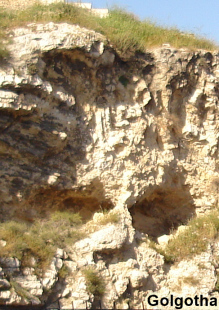In the above picture, the escarpment shown is roughly 100 yards (91.4 meters) east of the Garden Tomb. It is believed, by many, to be the Golgotha of the Bible where Jesus, and at least two other individuals, were crucified as criminals (Matthew 27:38, Luke 23:33).
The image above shows a rocky outcrop, located north of Jerusalem's old city walls, that is often called the "place of the skull" or "skull hill" due its resemblance to a dead and decomposed human head (sunken eyes, nose, etc.). The mighty Roman Empire conducted executions, like the one they performed on Jesus, at this location.
Linking locations
The link between Jesus, a skull and Golgotha (Calvary) can be found in the KJV gospel accounts. In the book of Matthew it is recorded that the Lord was led by the Romans to this location when it says, "And when they were come unto a place called Golgotha, that is to say, a place of a skull, They gave him vinegar to drink mingled with gall . . ." (Matthew 27:33 - 34, see also Mark 15:22 and John 19:17).

In early writings, references to this escarpment state it is a hill, found near a gate into the city of Jerusalem, that looks like a skull. Since 333 A.D., some writings that mention Calvary call it a small hill while others (dated from the 6th century A.D. forward) label it a mountain. The place of the skull, however, shown above is not where Catholic traditional says Jesus was crucified.
The traditional location of where Jesus hung on the cross and died was established by the Roman Catholic Church. It was based on the testimony of Helena, mother of Roman Emperor Constantine I (Constantine the Great) in 325. Helena also claimed to have found the place of his burial and to have discovered the "true" wooden cross on which he was crucified.
Constantine built the Church of the Holy Sepulcher around the whole site his mother said was where Jesus died. Prior to Helena's claim, a temple to Aphrodite, the Greek goddess of love, beauty, and sensual pleasure was on the site.
Excruciating pain
It should be noted that crucifixion is a slow and incredibly painful form of capital punishment. In fact, the English word "excruciating," meaning something extremely painful or intense, comes from the Latin word for torture or pain out of or from crucifying.
Crucifixion was utilized by the Persian Empire (559 to 330 B.C.), the Seleucid Empire (213 to 63 B.C.), the Carthaginians, Macedonians and the Romans. The Greek King Alexander the Great crucified 2,000 survivors from his siege of the city of Tyre in 332 B.C. In 337 A.D., Emperor Constantine abolished the practice of crucifixion throughout the entire Roman Empire.
Golgotha (Calvary) represents the final chapter and culmination of the earthly life of Jesus Christ. He lived a perfect life of thirty-three and one-half years so that, in 30 A.D., he could offer himself as the sinless, atoning sacrifice for all sins. One of the great paradoxes of Jesus and his ministry is that, by willingly offering himself at the 'place of the skull' or place of death, he made possible the gift of eternal life for those who believe in him.